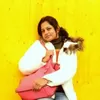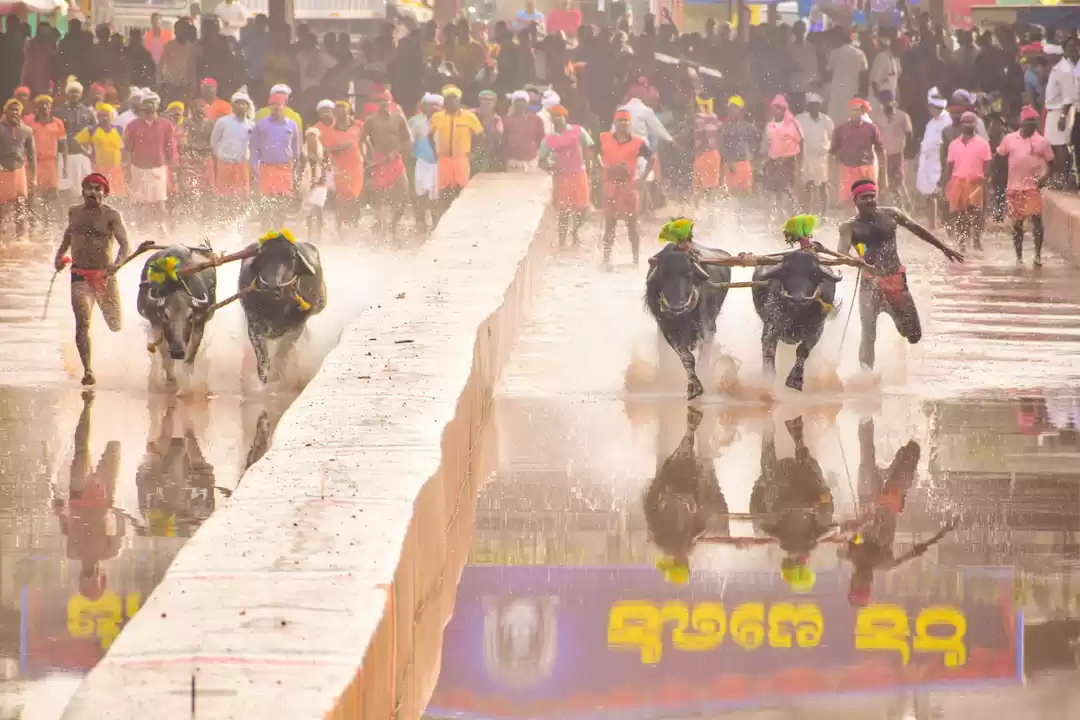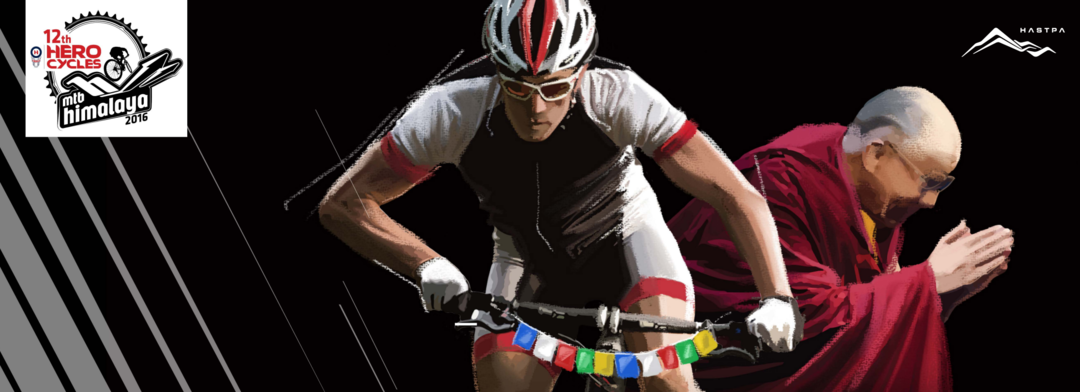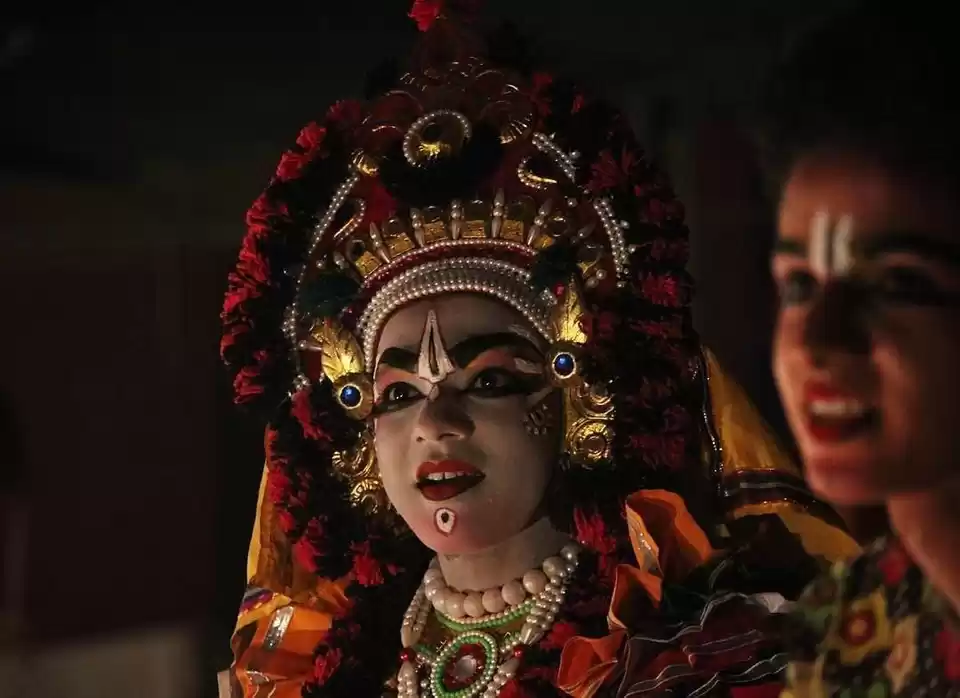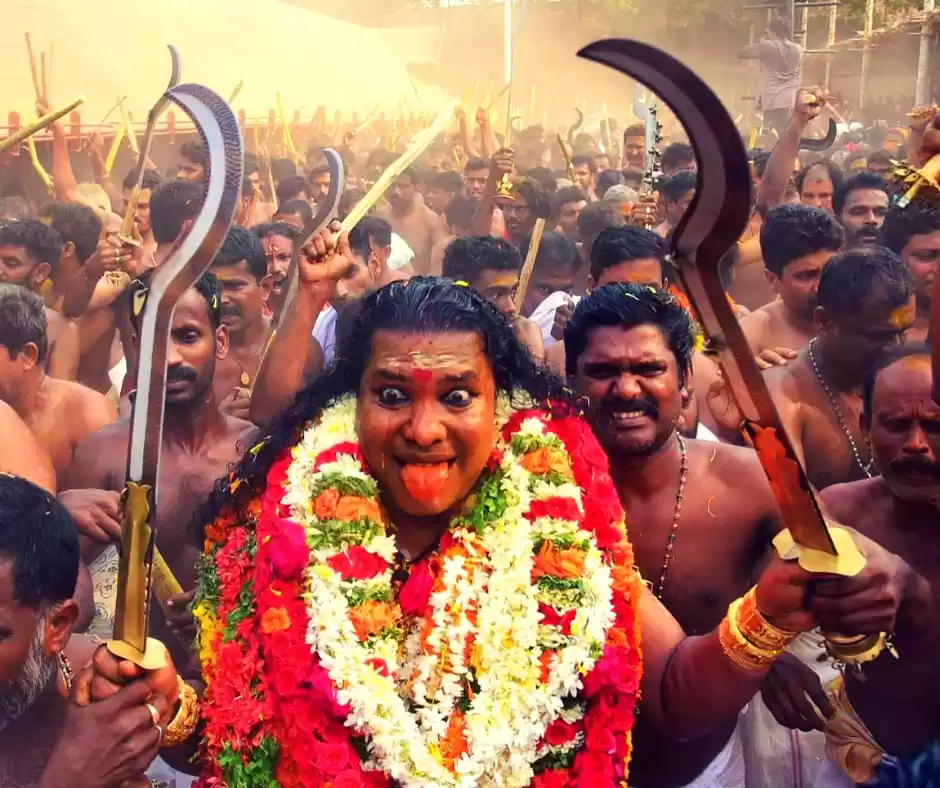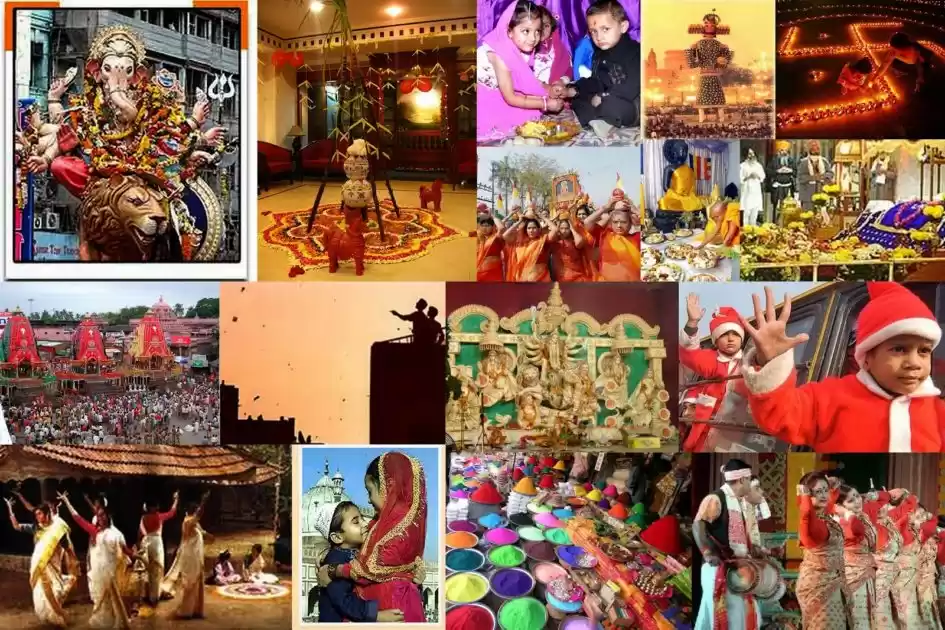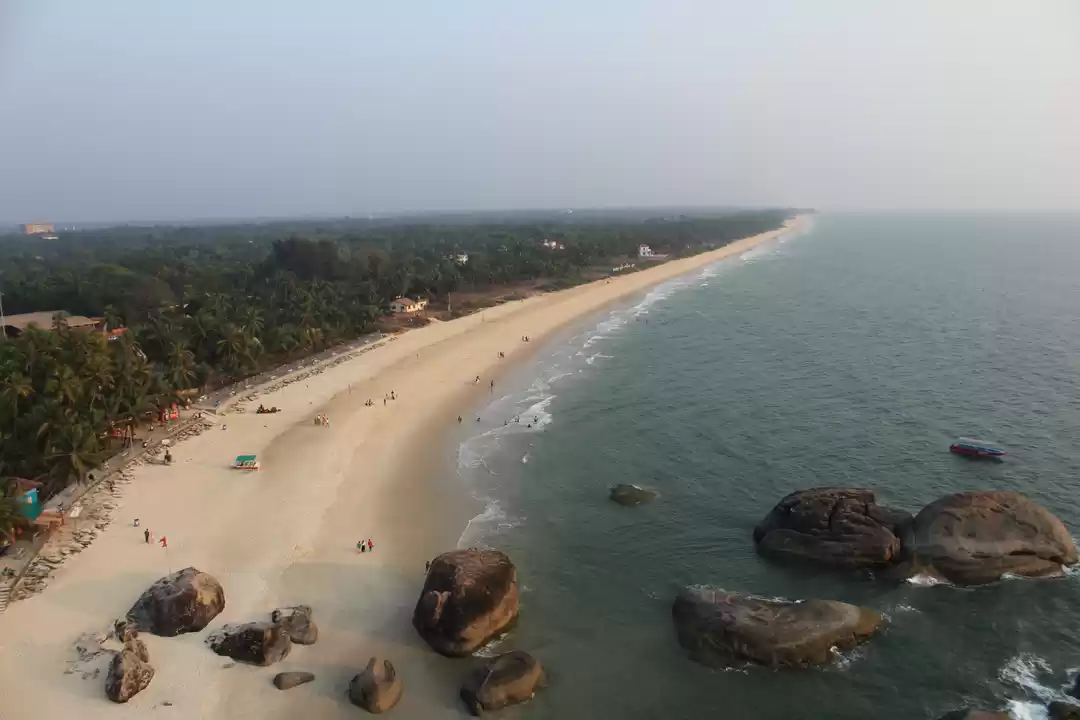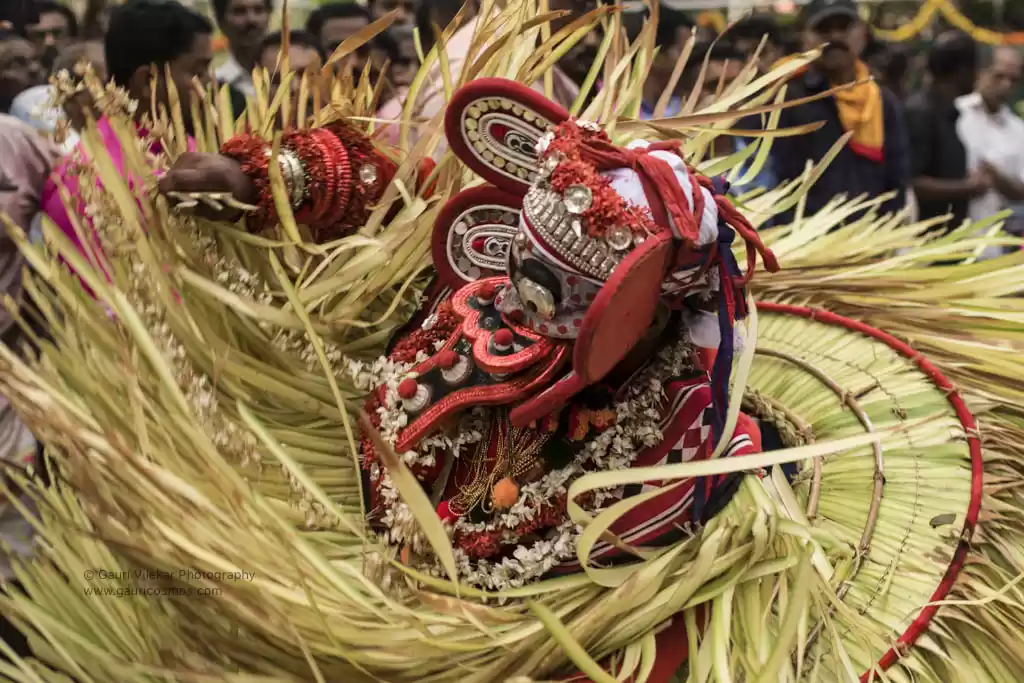
A hollow pitch has been laid on a moderately sized mud-ground. A 140-meter long race track filled with slush has been prepared with a concrete barrier in between. Bright satin Pandals have been placed on either sides of the track with rows of plastic chairs arranged neatly under its shade. Adjacent to the Pandal, is a raised podium to seat the VIPs. Few men move relentlessly, arranging chairs, bringing in coconuts and fixing the sound system. I get off the auto-rickshaw and walk towards a group of people standing at the far corner of the arena. I feel a bit anxious of their interrogative glances and questions, “Madam are you a reporter? Are you from PETA? Why do you want pictures?” However, it doesn’t take much time or effort to convince them over my identity and purpose of visit. Eventually, I notice a paradigm shift in attitude; their doubtfulness gets replaced with protectiveness.

It’s the last day of 2017 and I am in a small hamlet called Madhava Nagara in Surathkal, the suburb of Mangalore, to witness an ancient sport called 'Kambala'. Kambala, the race of buffaloes, originated in Dakshina* and Uttara* Kannada regions of Karnataka and its inception is traced back to more than 300 years ago. The race is held in different villages across Mangalore every year between November and March.
I am pulled by the scintillating aromas of food from the far side of the ground. I pay as little as INR 50 for a lavish breakfast of Idlis, Vadas, Avalakki*, spiced chickpeas, and Kesribaath* topped with a generous supply of steamy hot coffee. At 10 am, the costal sun is hitting me already. I wrap my face up in my stole, wandering around like a goon. A three-foot tall brass lamp decked with garlands is placed in front of the race track. A cluster of men from the Panchayat* gather in crisp white shirts and Lungis*. A coconut is broken before the lamp in one swing by the Sarpanch* and its water is sprinkled on everyone around. Hymns are being chanted aloud as he lights the lamp. A Poojari* in a green turban and red Dhoti* blows a Shankh* aloud and marks the commencement of the event. A melodious tune emanates from the sounds of two local percussion instruments- the Thavil* and the Nadaswaram*. After what seems like an eternity of wait, the first of the buffaloes ushered by a trail of thrilled men and dancing kids make their grand entry. The buffaloes look well-fed, almost royal and at the best of their health! Their black and lustrous skin massaged with pure coconut oil gleams under the sun. With their horns garlanded, their faces adorned with vibrant ornaments and their heads smeared with a generous blob of red teeka*, these were by far, the most handsome lot of buffaloes I have ever seen!
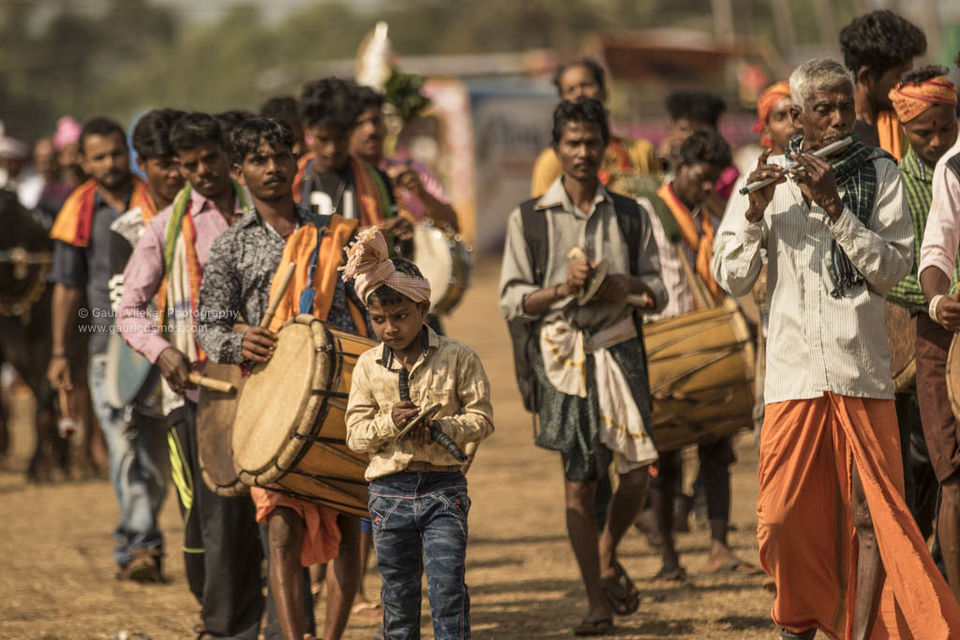
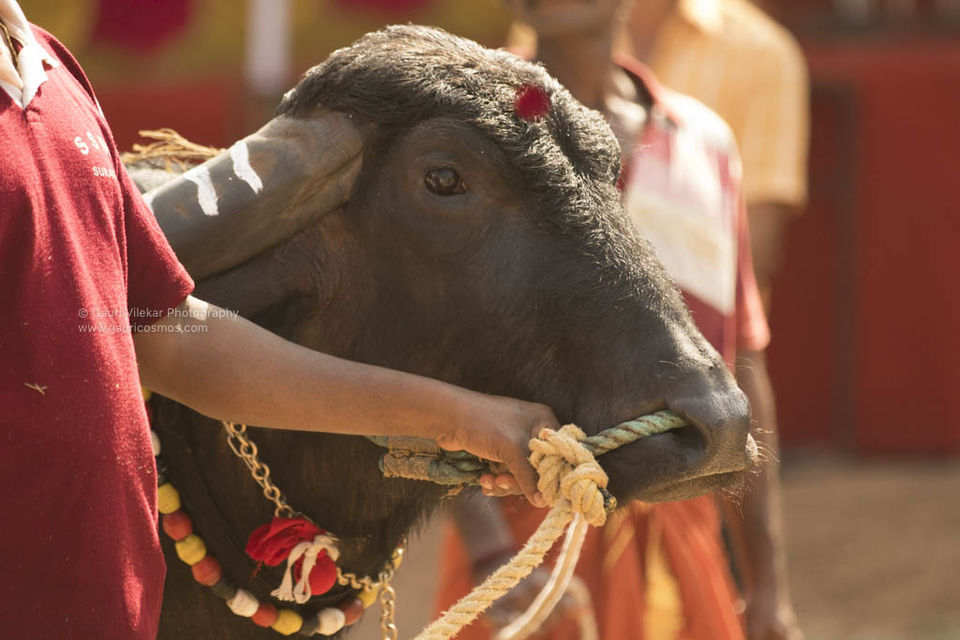
The first phase of the practice session begins. Two buffaloes, along with their masters (farmers/owners), take their stands on either sides of the partition. Their bodies and nostrils are splashed with water. The masters toss water over their own heads and drink some of it too, as an auspicious gesture. All is set for the first race. A committee member makes an announcement that gets blasted on a loudspeaker. Within a split second of his signal, the buffaloes begin their torrential run, gushing a fountain of slush all the way. Their masters run with them, yelling and nudging them to move faster. As soon as they reach the end of the track, they jump up to the dry mud in one stride, where they are stopped and controlled by a group of men. Almost instantly, they cool the buffaloes down by splashing their heads with buckets of water. The total time taken by the buffaloes is detected by a laser placed at the end of the track and flashed on the analog screens. The first set of buffaloes have finished their race in 13.5 seconds. The buffaloes are further taken backstage where they are bathed with generous buckets of water pulled from a large tank.
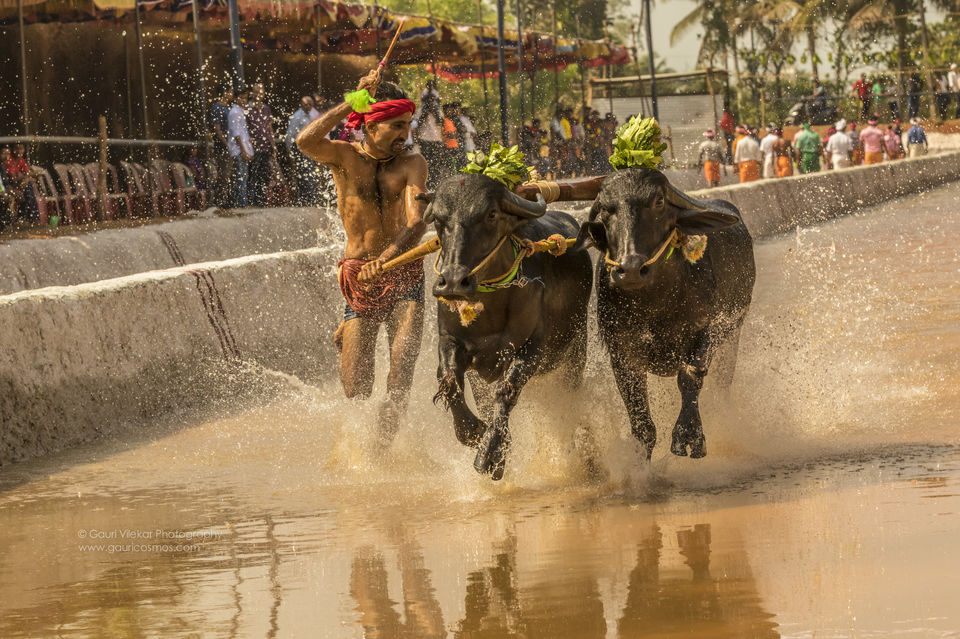
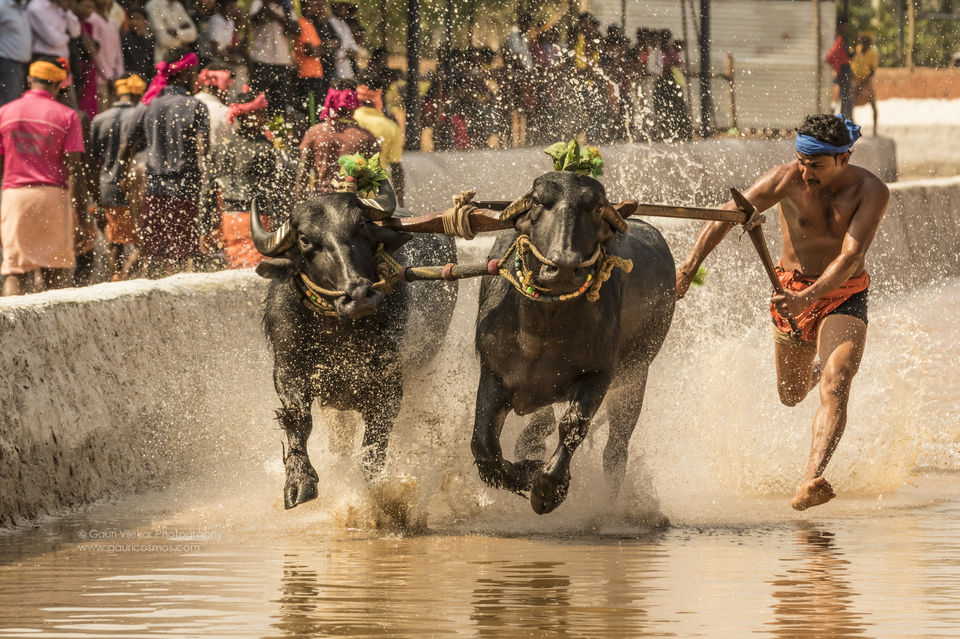
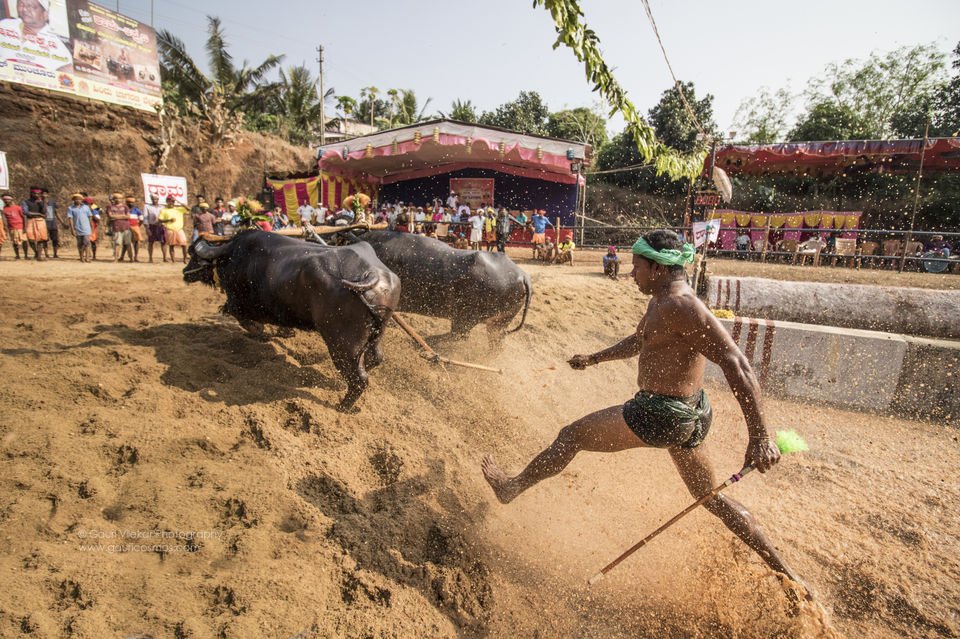
Another pair of buffaloes follow, yet another and another. Mr. Vidyadhar Jain, a core committee member and announcer for the event, tells me that “Kambala” originally was a royal sport and the winning master usually received only a coconut as his prize. Gradually, as the sport evolved, Samiti’s* were formed. Coconuts were swapped with gold coins. Manual judgements were upgraded to laser detectors. However, more than anything else, the respect and pride earned as a winner matters the most to the contestants. Few farmers have been proud champions of the race year on year. The participating buffaloes are treated with utmost care. There is no compromise on the purity of the coconut oil used for their massage and their fodder is of supreme quality! Few of them have even have private swimming pools and air-conditioned rooms!
As the practice gains momentum, the race is run between two pairs competing against each other on either sides the barrier. I am fascinated to see the temperaments of the buffaloes and their masters. Some are polite and obedient, while others are stubborn and arrogant. Some buffaloes are getting a pat by the owners for outsmarting the competitor, while some are being yelled abuses for not performing upto the mark. Having said that, the highs and lows are just in the spur of moment. It is evident that the owners love their buffaloes to death! My attention drifts from the buffaloes to their bare chested masters. I am amazed to see their six-pack abs, thunder arms and muscular built! After around 30 races, the first demo for buffaloes under 6 years is over. My eyes are glued to the action and my camera has taken 300 shots already!
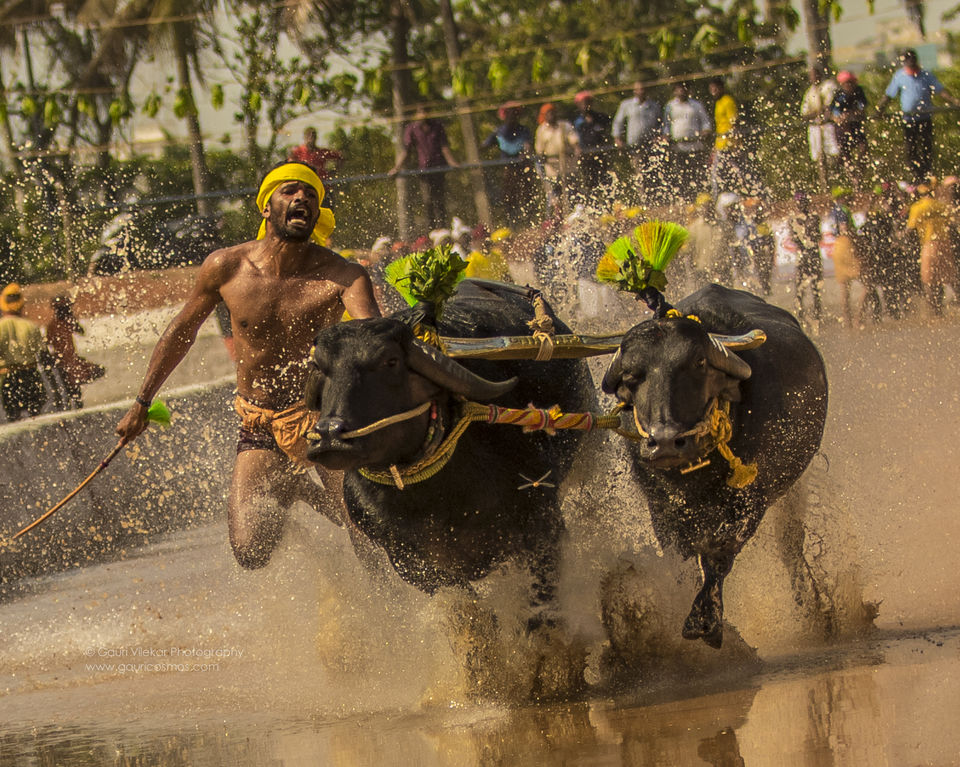
The second leg of practice is to begin soon. I am given free lunch coupons by the Samiti. As I walk towards the tent serving lunch, I uncontrollably proceed towards the stalls selling junk. I start with a long glass of sweet sugarcane juice, followed by some Bhel*, hot masala Vadas and end with some tangy local version of veg Manchurian! Upon my return, I confess to them about how I fell prey to my sinful urges and apologetically, give back the coupons; making way for some unexpected giggles and laughter!
Kambala comprises of four varieties of races- a) Hagga Kambala- in which, the master runs with a rope directly tied to the buffalo’s nose, b) Neligu Kambala- the master runs with a plough tied to the buffalo, c) Adda Halage Kambala- the master stands on a wooden plank tied to the buffaloes while the race is in progress and d) Kenne Halage- the master stands on a disc shaped wooden block with holes that propel a huge spray of slush during the race. Of these, the Hagga Kambala is for entry level buffaloes and the rest are for the age group of over 6 years.
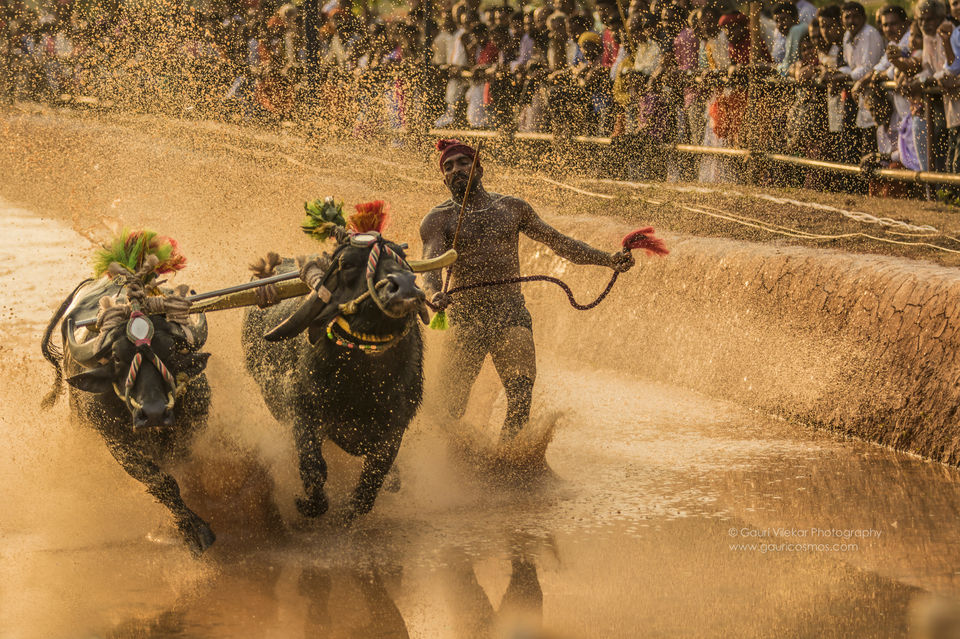
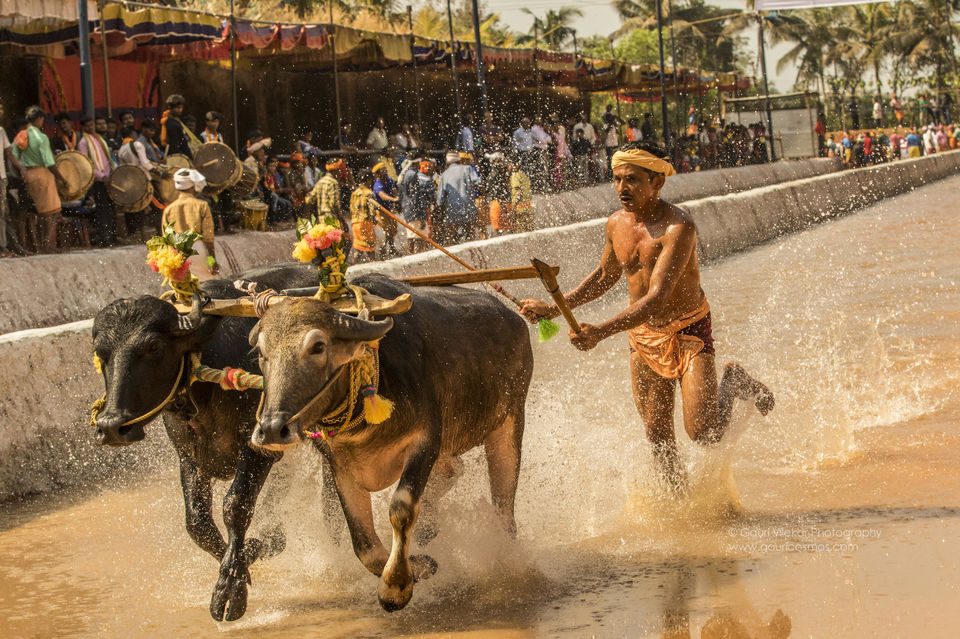
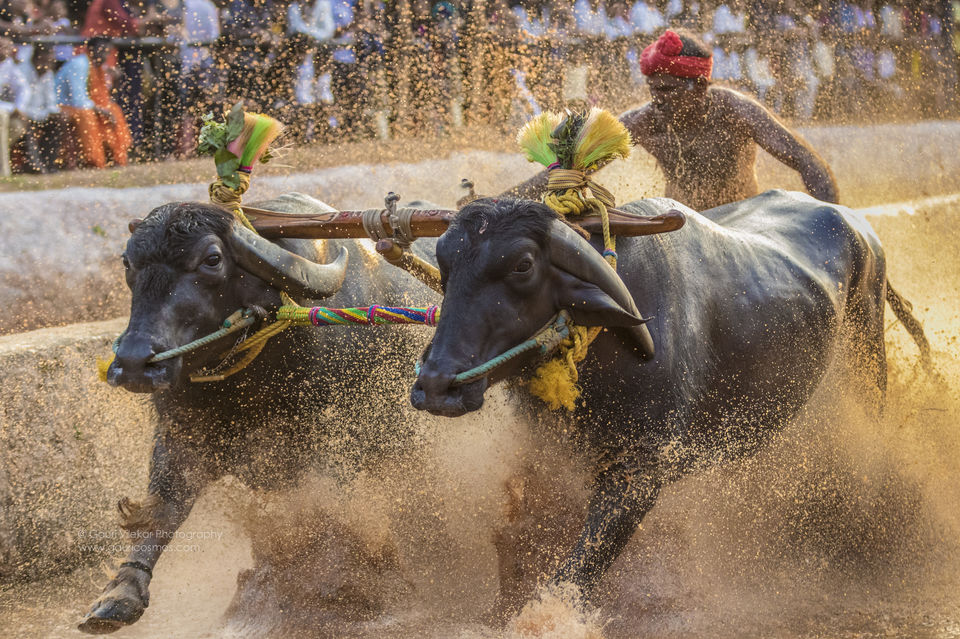
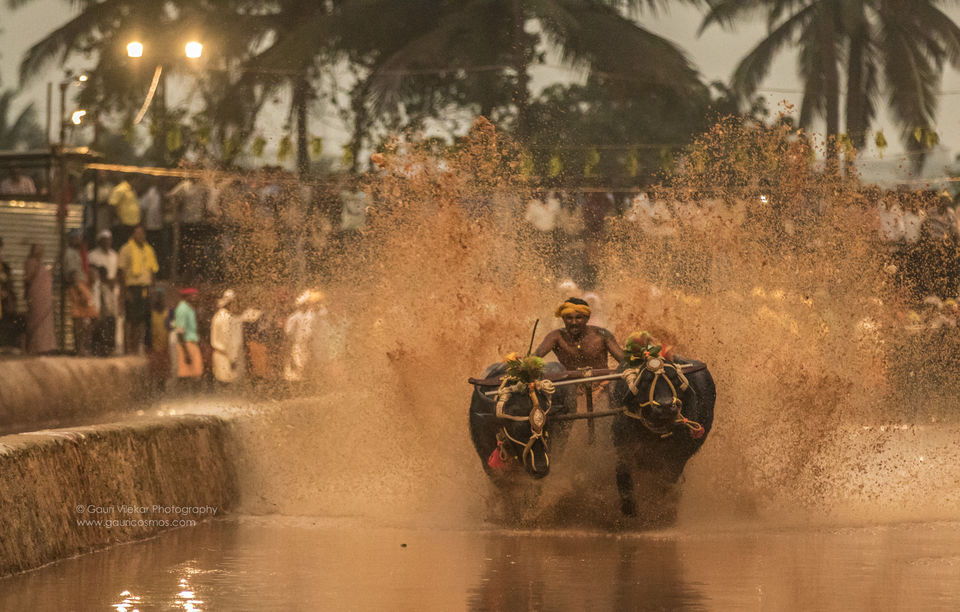
The second phase kicks off and this series seems more action-packed with buffaloes over 6 years of age entering the pitch. The venue now has close to two hundred onlookers. The Neligu Kambala has begun. I am gripped by the pumping energy levels of the raging hefty buffaloes and their masters running neck to neck at lightning speeds. I almost reach to the edge of the concrete fence to capture their expressions. Each time a buffalo zooms past me, I pull back just in time, saving myself and my camera from getting drenched in the mucky shower. I am loving the bouts of adrenaline rush from this little stunt. The practice session draws to an end with the last round of Adda Halage Kambala.
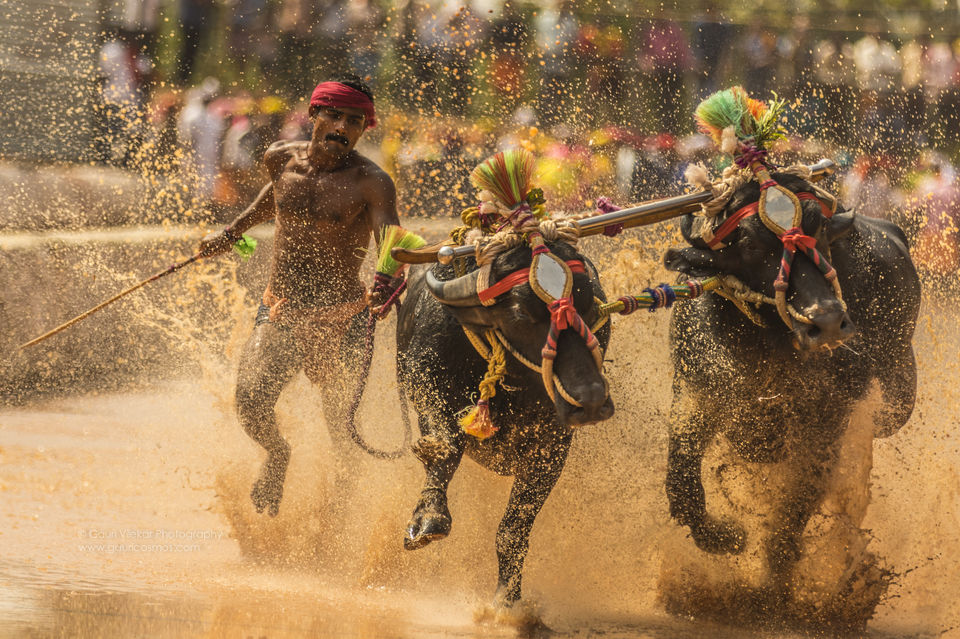
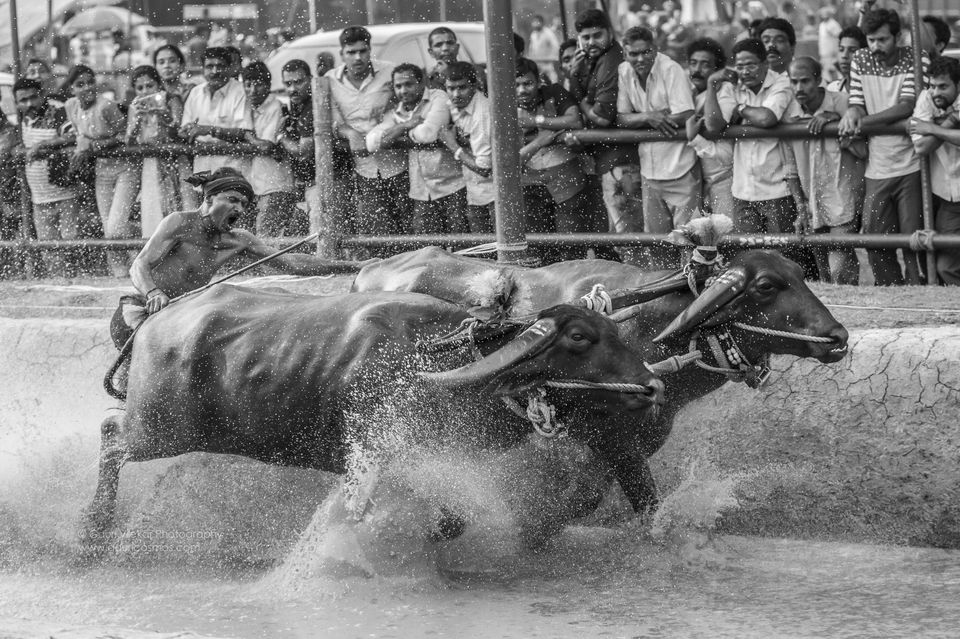
Finally, with the sun going down, the finals are announced! A beautiful sunset unfolds in the backdrop behind the coconut and palm trees. The crowd has touched almost seven hundred and now comprises of women and kids as well. The raised podium overflows with politicians, policemen and village heads. The first set of buffaloes hit the track. With speeds multiplied, the difference in distances are as meagre as 0.1 and 0.2 seconds. The ornamental decoration on the buffaloes have gotten elaborate and prettier. The air bursts with screams, abuses, cheers and claps. The loudspeakers are blaring with pumping Hindi and Kannada tunes being played by the live orchestra. The oomph around me is electrifying, almost insane!
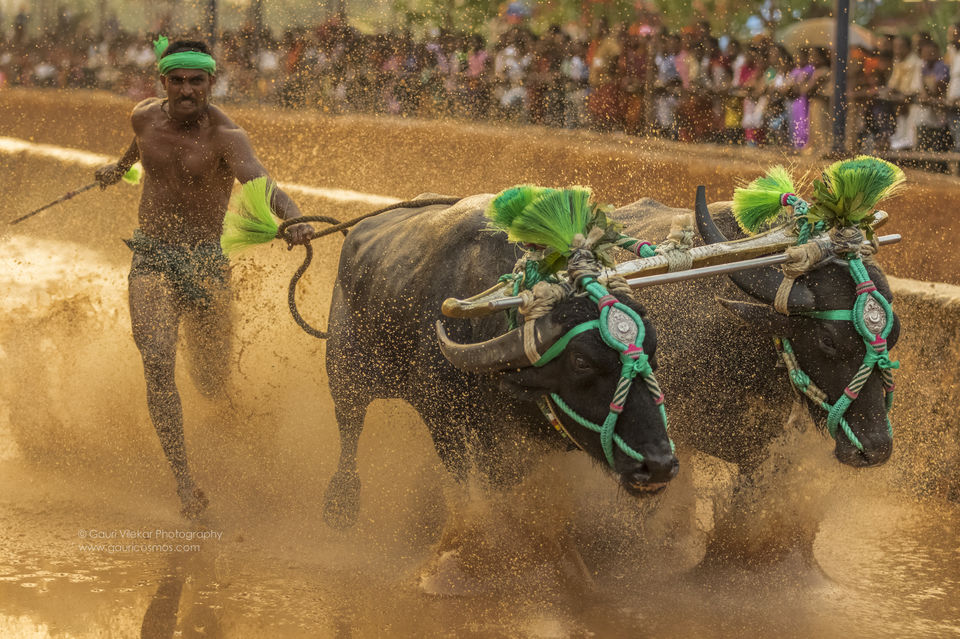
Suddenly there is a long and intonated ‘ooooooohhh’ from the audience. A master, whilst shoving his buffaloes to run faster, has tripped and fallen in the muck! His buffaloes, though, continue to race beyond the boundary line. The master walks behind them with heavy foot; his head held low. Next; a pair of overexcited buffaloes win the race and return to the pitch for a re- run! The crowd roars with laughter as the big lads are pulled back to the ground. Meanwhile, there is a huge commotion at the other end where the next set of contesting buffaloes are supposed to be ready, but are too adamant and are acting pricy. After about fifteen minutes of push and pull, the group gives up and retreats, making way for the next contenders, but makes a re-entry in no time.
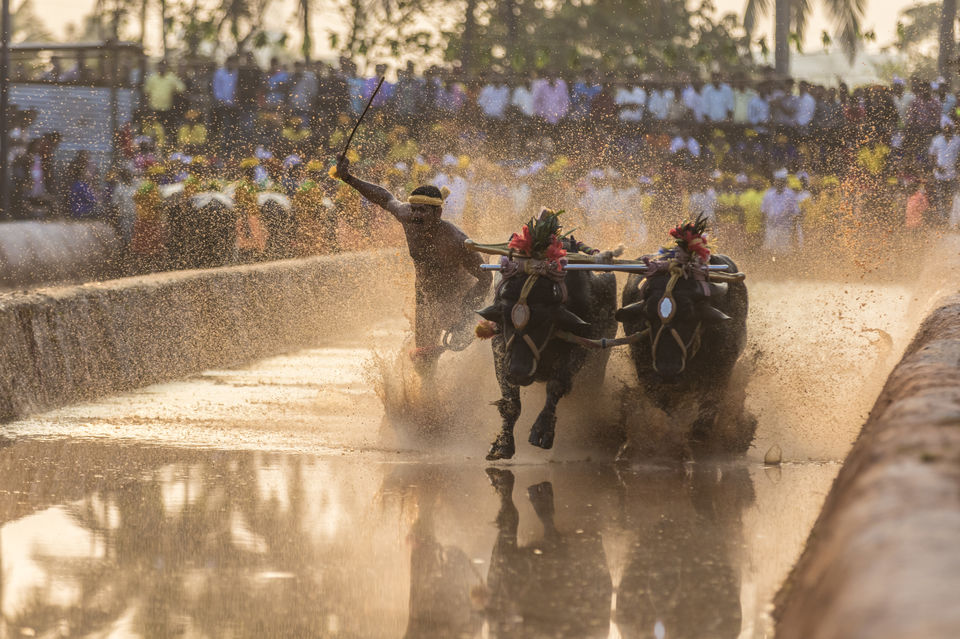
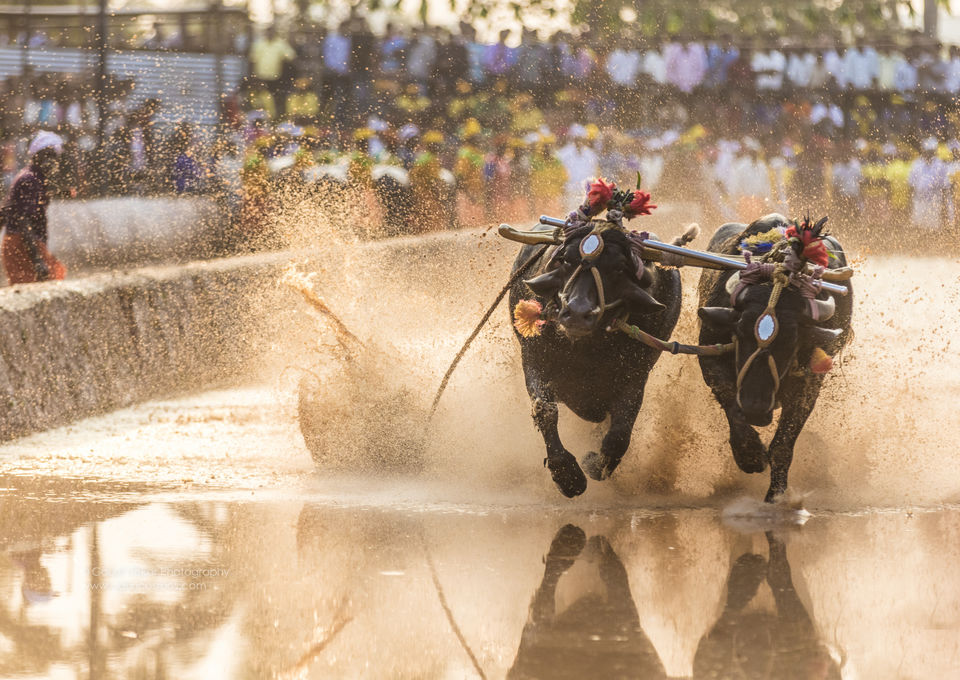
Next up, the 'Kenne Halage' begins under the floodlights. The masters are on a frenzy and seem to be flying through the track. The speed propels voluminous jets of slush, reaching over fifteen feet! I witness the action, absolutely flabbergasted! Night creeps in, but the races are in full swing and would continue till the first rays of dawn. The buffaloes and their masters have a long way to go before the final winner is declared. One man will walk away next morning with his head held high with two of his four legged sons by his side. The winner would return to run the Kambala next year, even stronger and the ones who lost would try harder with hopes in their eyes and storm in their feet.
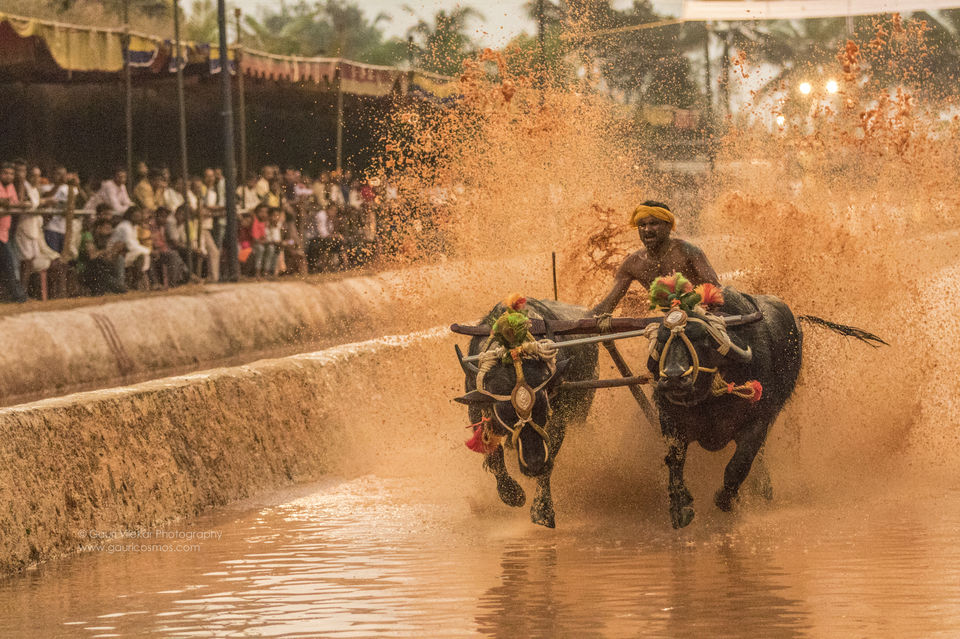
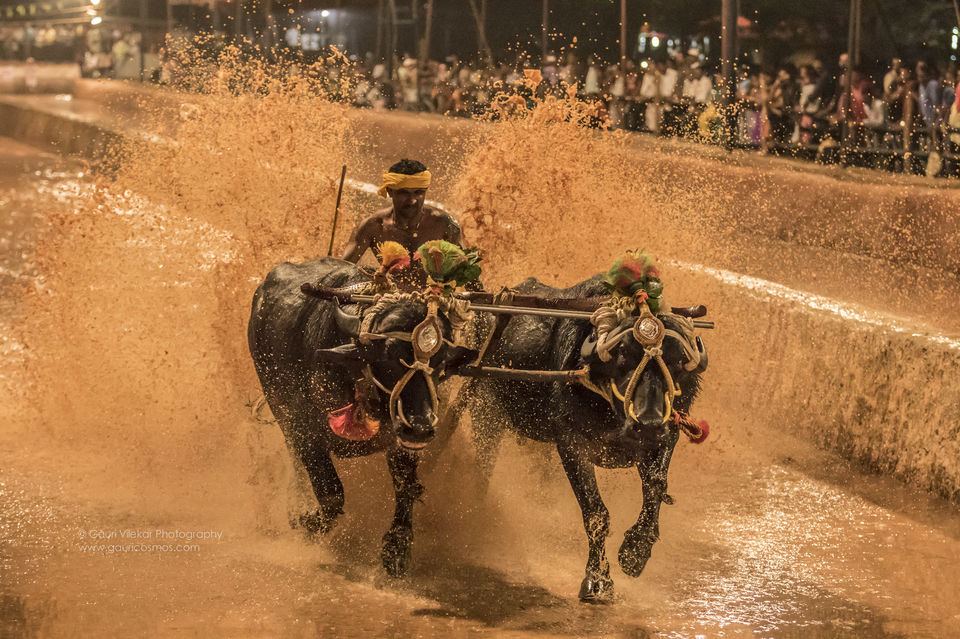
At 9 pm, I decide to wind up, but not before thanking the Sarpanch; an old, kind-hearted man, somewhere in his eighties. He hands me a beautiful cane-whip festooned with colourful rayon strings at its tail end. In a feeble voice, he says, “The whip for us, is a token of love and respect. This is a gift from our village to you, it was our pleasure to have you here. Please do visit again!” Overwhelmed, I manage to hold back my tears behind a pressed smile. Voices drown as I walk away from the Kambala, holding the whip in one hand and a mixed bag of emotions in the other..
Glossary:
Pandals- A temporary shed
Uttara- North, Daskhina-South
Panchayat-Village council
Idlis, Vadas, Avalakki - Common break fast items of South India. Avalakki is an equivalent of Poha.
Kesri-baath -sweet delicacy, equivalent to Sheera/Suji ka Halwa
Lungis/Dhotis - traditional attire of rural India men
Poojari- temple priest
Sarpanch- head of a village
Shankh- conch shell
Thavil - type of drum and Nadaswaram -type of trumpet.
Teeka – customary generous blob of dry red color daubed on the forehead
Samiti- Committee
Bhel- Indian street delicacy made of puffed rice.
Snippets :
When : Between November to March. Dates changes each year but are easily available on the net.
Where : Different parts of Uttara and Dakshina Kannada.
Duration of the event – 24 hours
Accessibility : very easy. Buses ply from Bangalore to Mangalore. Autos/ buses can be taken from Mangalore to the respective village depending upon the proximity.
Stay : Not required. Nearest city- Mangalore is loaded with hotels.
Essentials : light clothing, loads of sunscreen
Recommendation for solo women travellers : Totally safe!

